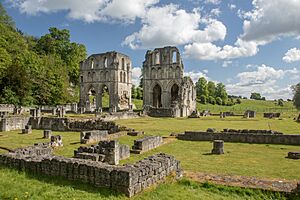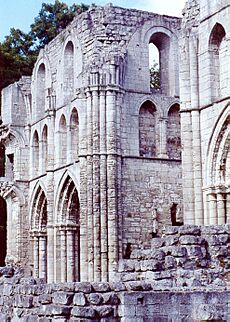Roche Abbey facts for kids
Quick facts for kids Roche Abbey |
|
|---|---|
 |
|
| Type | Abbey |
| Location | Rotherham, South Yorkshire |
| Governing body | English Heritage |
| Owner | Private |
| Official name: Roche Abbey Cistercian monastery, including monastic precinct, gatehouse and 18th century landscape garden | |
| Designated | 8 February 1911 |
| Reference no. | 1019059 |
| Official name: Sandbeck Park and Roche Abbey | |
| Type | Grade II* |
| Designated | 1 June 1984 |
| Reference no. | 1001161 |
| Lua error in Module:Location_map at line 420: attempt to index field 'wikibase' (a nil value). | |
Roche Abbey is a beautiful ruined abbey located in Maltby, near Rotherham, South Yorkshire, England. It sits in a valley next to a stream called Maltby Beck. Today, English Heritage looks after this historic site. It is a very important historical place, protected as a scheduled monument and listed in the National Register of Historic Parks and Gardens.
Contents
The Abbey's Beginning
How Roche Abbey Was Founded
Roche Abbey was started in 1147. Monks from Newminster Abbey in Northumberland came to South Yorkshire. They chose a spot by the stream to build their new Cistercian monastery. The Cistercians were known as the "White Monks" because of their simple white robes.
Two men, Richard de Busli and Richard FitzTurgis, helped found the abbey. They both gave land for the monks. They wanted the abbey to be built on the best spot, no matter whose land it was on.
Building the Great Church
About 25 years later, by the end of the 1100s, the main church was finished. This church was built in the Norman Gothic style and was dedicated to the Virgin Mary. Most of the other abbey buildings were also completed around this time.
The de Vesci family, who were lords of Rotherham, had control over the abbey. They passed some of this control to Richard FitzTurgis.
Life at the Abbey
Roche Abbey had a special, peaceful feeling. It was built near the edge of what was once Sherwood Forest. There's even a legend that Robin Hood himself attended Mass here!
At its busiest, the abbey was home to about 175 men. Around 60 of these were choir monks, who spent their days in prayer and study. The rest were lay brothers, who did most of the physical work.
Who Owned the Abbey?
After Richard FitzTurgis died, his son Roger took over the abbey's control. Later, it passed to Roger's granddaughter, Constantia. She married William de Livet, whose family owned the nearby village of Hooton Levitt.
The Levett family continued to be involved with the abbey until 1377. Then, John Levett sold his rights to a London merchant named Richard Barry. Finally, by the time the abbey was closed down, Henry Clifford, 2nd Earl of Cumberland, had full control. He was related to King Henry VIII.
The Abbey's End
Why Roche Abbey Became a Ruin
Sadly, most of the records from Roche Abbey are lost. We know that in 1538, there were 14 monks living there. On June 23, 1538, King Henry VIII ordered the Dissolution of the Monasteries. This meant that many abbeys, including Roche, were closed down.
This event led to Roche Abbey becoming a ruin. People from the local community felt they had a right to the abbey's belongings. They took large amounts of timber, lead, and stone from the buildings.
What Happened During the Dissolution
A man named Michael Sherbrook wrote about what happened at Roche Abbey. He was a child when the abbey was closed. His uncle, who was there, told him the story.
Sherbrook described how the church was the first building to be stripped. Then, the abbot's home, the sleeping areas, and the dining hall were ruined. Everything inside the abbey walls was taken apart. Only the animal shelters outside the walls were left alone.
He wrote about how sad it was to see the lead being torn off the roofs. The wooden boards were pulled up, and the rafters thrown down. Even the tombs of important people inside the church were broken open. The monks' choir seats were burned, and lead was melted down. People took whatever they could find, even pewter dishes hidden in the rocks. It seemed everyone wanted to take something.
Later Changes to the Site
After being left in ruins, the land changed hands many times. In the 1700s, the 4th Earl of Scarbrough decided to improve the area. He hired a famous landscape designer named Capability Brown. Brown made big changes, even demolishing some buildings and covering parts of the site with earth and grass.
Because of Brown's work, Roche Abbey remained hidden for a long time. It was buried under his landscaping and trees until the 1920s. Then, new excavations brought the abbey's ruins back into view.
Roche Abbey Today
Today, Roche Abbey is cared for by English Heritage. Visitors can walk along a cliff path to get a great view of the abbey grounds. You can see the full layout of the buildings from above.
While some parts are low walls, the main church walls still stand tall. You can still see the beautiful French Gothic design in its architecture. Later additions to the abbey included a kitchen and the abbot's living area. These were built on the other side of the stream and could be reached by a bridge, which is still there.
The monks were quite clever for their time! Their latrines (toilets) were built over Maltby Beck. The stream was even dammed higher up to make sure the water flowed fast, carrying away waste. This was a very modern system for the 13th century.
There are also some fun local legends about Roche Abbey. People talk about ghosts, secret tunnels leading to other buildings, and even a lost wishing well!
Burials at the Abbey
The nave, which is the main part of the church, was where the lay brothers were buried. Other people from outside the abbey community were also buried here. These included Peryn of Doncaster and his wife, Ysabel. There is also a tomb from the 14th century belonging to the Rilston family, who were likely important local people.


